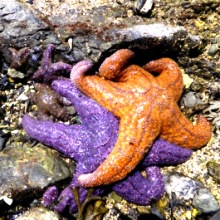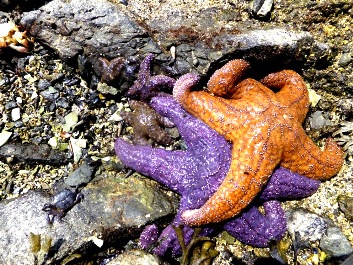Thursday Nov. 19, 5:30 to 7:30 pm at Orcas Center
— from Russel Barsh —
The “blob” of unusually warm water that has dominated North Pacific weather for the past two years is the focus of this year’s Celebrate Indian Island event at Orcas Center on November 19, sponsored by the Indian Island Marine Health Observatory and the conservation nonprofit Kwiaht. Doors open at 5:30 p.m. and as always the event is family friendly and free, with finger food and refreshments accompanied by the music of Sharon Abreu and Michael Hurwicz.
This year’s event marks the seventh consecutive year of community monitoring and stewardship at Indian Island, where the number of visitors has increased significantly topping an estimated 8,000 in summer 2015. The island is a part of the San Juan Islands National Monument proclaimed by President Obama and administered by the Bureau of Land Management.
“There is good news and bad news,” says Kwiaht director Russel Barsh. “We are seeing a strong recovery of Ochre sea stars from last year’s episode of wasting syndrome. Some of the fish species we monitor have also done better this year. But other inter-tidal marine animals, including other sea star species, as well as crabs and sea slugs, appear to have declined since 2009.”
Barsh observes that the eelgrass meadow around Indian Island is slowly thinning, and hard-shelled clams are gradually being replaced beneath the beach by species that are better adapted to muddy sand than to coarse sand and gravel. “These changes are likely to be connected to rain runoff from Eastsound streets, which makes shallow waters cloudier, reduces the sunlight reaching seagrasses, and feeds the beach more fine sediments.” Algal blooms can also benefit from, and add to the shading effects of nutrient rich runoff.
Muddier water can affect marine animals that filter suspended food particles, such as sea anemones and the Flattop Porcelain Crab, the mascot of the Indian Island program, Barsh says. “Add to this a long summer of very hot dry days and warm water, and inter-tidal animals have a problem staying alive. Those that can, move to deeper waters.”
Unprecedented summer temperatures, drought, and severe winter storms will all contribute to making our nearshore habitats less attractive to many marine species, Barsh says. “The most we can do for now, is reduce stress from sources under our direct control such as pollution and the physical disturbance of inter-tidal habitats.”
The Kwiaht sponsored program has made significant progress restoring uplands at Indian Island by designating a single viewpoint and access trail, and encouraging visitors to avoid disturbing nesting birds. Native wildflowers are blooming again on a half-acre of the island that had been heavily trampled over the years, leaving patches of bare earth and rock. Oystercatchers, Killdeers, Rough-Winged Swallows and White-Crowned Sparrows all nested on the island in 2015.
“We need to consider carefully what we can do, if anything, to conserve the inter-tidal ecosystem better,” Barsh says. “This is a community decision. The island may not be able to sustain more tourism and still be here for local families and students.”
Kwiaht also announced the launch of a Grade Six class project, supported by the Rose Foundation, that is learning about the chemistry of household soaps, cosmetics, and emulsifiers in the marine environment, and will be making a video “informercial” on this topic working with Milla Prince, winner of this year’s Orcas Island Film Festival feature film competition.
Learn more about the changing Indian Island and East Sound marine ecosystem; enjoy a musical serenade of new and old songs by Sharon and Mike; share a light buffet catered by Orcas Village Store and local volunteers; and find out how you can be a part of caring for Eastsound’s “window to the sea”: Celebrate Indian Island, at Orcas Center, Thursday November 19, 5:30 to 7:30 pm.
**If you are reading theOrcasonian for free, thank your fellow islanders. If you would like to support theOrcasonian CLICK HERE to set your modestly-priced, voluntary subscription. Otherwise, no worries; we’re happy to share with you.**










Wonderful offerings. Thank you for all you bring into our awareness and community